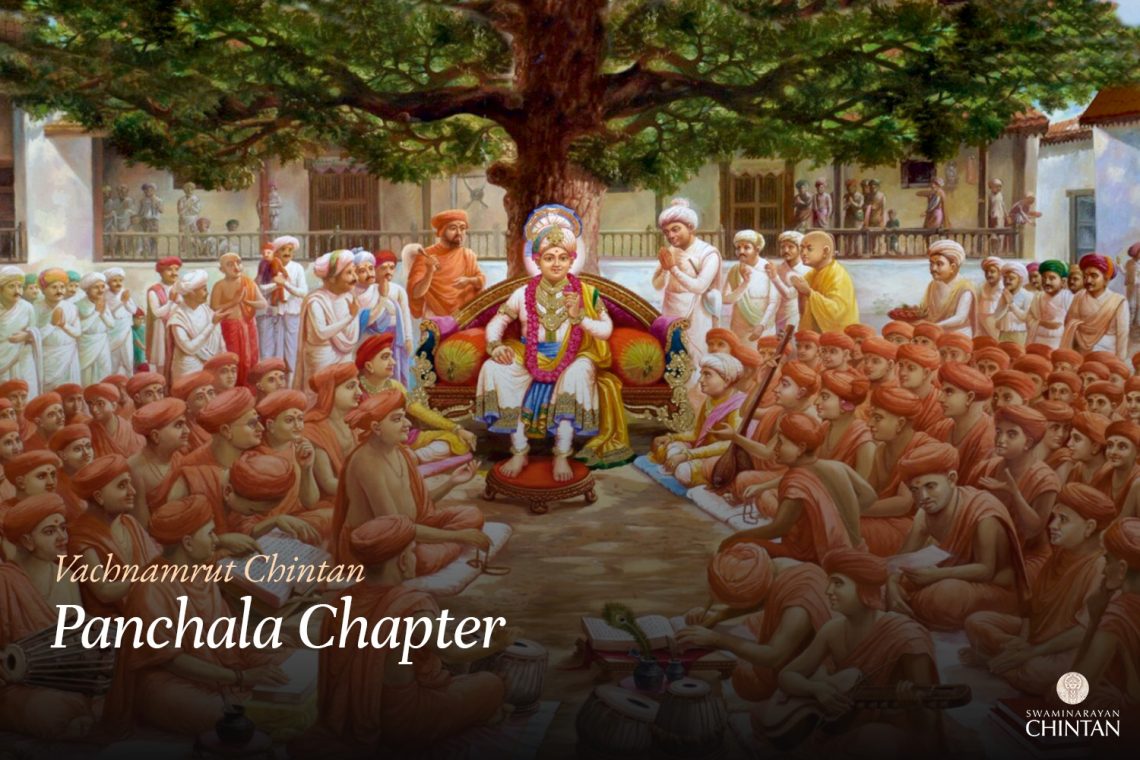Central Insights:
- Firmness of conviction.
Main Points:
- One should truly understand both Bhagwan’s divine form and His human form during incarnations.
- While perceiving Bhagwan in His human form, one should maintain awareness of His divine form.
Commentary:
This Vachanamrut emphasizes the importance of developing firmness in conviction. In the Vachanamrut, Munibava asked Brahmanand Swami a question: “At first, one may have firm conviction in Bhagwan, engage in devotion and remembrance, but later, upon seeing Bhagwan’s human actions, one’s conviction begins to waver. What is the reason for this?”
Since Swami was unable to provide a satisfactory answer, Maharaj thought for a long time and then explained: “The Veda and other Shastras describe the eternal, beginningless, and divine original form of Bhagwan residing in His Akshardham. This has been stated and described in the scriptures, and it has also been mentioned how Bhagwan behaves when He assumes a body in the universe. Firm conviction is to view both of these forms together and develop steadfast faith in the jiva (soul). These two forms are not separate. The separation is only described in words, to help people understand or internalize the concept of ‘this’ and ‘that.’ In reality, there is no duality between the two forms. When this understanding becomes firmly ingrained in the jiva, that is called nishchay (firm conviction or firm faith). If someone has attained a high level of firmness in this conviction, they will never experience doubt regarding Bhagwan’s human form. The more one’s conviction lacks firmness, the more doubts arise.”
Therefore, one must thoroughly understand Bhagwan’s divine form residing in His eternal dham (abode) and also comprehend how He behaves when He incarnates in the universe. One should know what He does and what He does not do. After perceiving both the divine and human aspects as one single form, one should eliminate any perception of Bhagwan’s human nature and develop firm conviction. Once this conviction becomes extremely firm, no doubt about Bhagwan will arise.
In this Vachanamrut, Maharaj explains, “What is Bhagwan’s divine form that resides in His dham? The form of Bhagwan that we perceive with our Indriyas (senses) is not like anything that we see in this world. Bhagwan’s form is extremely divine, extraordinary, blissful, and beyond imagination. The shabda (sound), sparsh (touch), rupa (form), rasa (taste), and gandha (smell) that we perceive through our senses do not correspond to Bhagwan’s image. Instead, Bhagwan’s form consists of shabda, sparsh, rupa, rasa, and gandha that are far superior, incredibly extraordinary, and provide an immense joy that transcends our imagination. Bhagwan’s form is infinite and beyond the reach of the subjects of the Antahkaran (inner faculties). Moreover, nothing in this Brahmand (universe) can be compared to Bhagwan or His form. Likewise, the bliss that resides in Bhagwan’s dham cannot be compared to anything else. Bhagwan’s form and beauty are unparalleled in any of the countless universes. There is no one to whom Bhagwan’s form can be compared.”
Even between similar beings, such as humans, there isn’t much resemblance. Maharaj says, “Take Bhago and Mulo, for example. They may seem identical at first glance, but after spending a few days with them, one can perceive their differences. So, how can one compare the extraordinarily divine form of Paramatma to anything else? Moreover, how can we even think of comparing the Mayic (material) and the Amayic (spiritual)? It’s simply impossible. This is the nature of Bhagwan’s divine form residing in His dham, where He is the king of all kings and is surrounded by infinite divine opulence.”
Maharaj further explains, “Just as the wealth of a great emperor cannot be measured, what can one say about the immeasurable wealth and power of Bhagwan? Even deities like Brahma, Vishnu, and Shiva constantly offer their prayers to Him. Such is the divine nature of Bhagwan. However, when Bhagwan incarnates in this universe, He behaves according to the body He assumes. If He assumes a human form, He behaves according to the customs and norms of that era and acts according to the age, situation, and manner of the people of that time. Yet, He does not reveal the divine brilliance of His form in the same way He does in His dham. He goes through stages like birth, childhood, youth, and old age, and He displays human emotions such as illness, fear, crying, anger, and attachment. He also shows feelings of ‘mine and yours’, favoritism, hunger, thirst, etc. However, Bhagwan does not transcend these human traits and behave in His purely divine manner. This is called ‘following the human drama.’ The Shastras also describe this aspect of Bhagwan. If one listens, contemplates, and firmly understands both His divine and human forms, one will not lose conviction upon seeing Bhagwan’s human actions. However, if one lacks a proper understanding of this, doubts about Bhagwan will arise.”
Maharaj says, “When Bhagwan performs human actions, if a mumukshu (seeker of liberation) or a sincere practitioner, who is intelligent and focused on Atma-kalyan (spiritual well-being), sees signs of lust, anger, or ‘mine versus yours’ in Bhagwan, they should realize that these qualities are not the same as they appear in the people of this world; they are distinct. This realization arises in their heart. Even in the true devotees of Bhagwan, such as Ekantik (single-minded) Santo, if there are signs of selfishness or a sense of ‘mine and yours’, those qualities are still different from the same traits in worldly people. If one can experience this distinction in devotees, how much more evident would it be in Bhagwan Himself? Therefore, Maharaj explains that even the gnan (knowledge) and vairagya (detachment) of Bhagwan far exceed that of any being in this world, and they are capable of granting liberation to countless souls. If Bhagwan displays human characteristics, such as apparent faults, those too are not like the faults seen in other people, but they are distinct.”
Maharaj gives the example, “When Shankaracharya entered the body of a king’s prince, the wise queen could immediately sense that a different soul had entered her husband’s body. The romantic actions were there, but they felt distinct. Similarly, the discerning individual sees Bhagwan’s human actions but experiences them as being distinct.”
Maharaj further explains, “Some may doubt that if Bhagwan demonstrates a little bit of His distinct qualities, one’s conviction about His divinity will become firm, but if He shows even more miraculous powers, the conviction will grow stronger. Maharaj says this is not the case. There must be a harmony between Sajatīyata (sameness) and Vilakshanata (distinctness). As Bhagwan performs Sajatīya actions, if He occasionally reveals small glimpses of His distinct divine powers, it strengthens both the natural affection towards Bhagwan and the conviction of His divinity. This also reinforces the seeker’s faith in their own spiritual progress. However, if Bhagwan were to display grand miracles all at once, it would overwhelm the jiva, causing them to retreat in fear, rather than feeling any closeness or affection toward Him.”
Maharaj gives the example of Surya (the sun) and Agni (fire) to explain that merely seeing them does not bring about a sense of spiritual fulfillment in a person. However, one does feel that satisfaction upon having the Darshan of a true Sant. The reason is that the Sant is Sajatīya (of the same essence) to the person, while also possessing a slight element of Vilakshanata (distinctness). Therefore, Maharaj explains, the more Bhagwan shows human characteristics to His dedicated devotees, the more affection they feel toward Him. This creates a sense of oneness between the two, leading to an extremely firm conviction in Bhagwan.
For those who do not recognize the divine nature in Bhagwan’s human actions, or do not see the human qualities within His divine actions, they will either lose conviction or fall into doubt. Therefore, when Bhagwan behaves like a human, it is favorable to the jiva. If Bhagwan happens to act in haste for some purpose or reveals His divya (divine) nature to a devotee by His own will, His divine nature becomes apparent. Otherwise, Bhagwan is fully capable of concealing His divinity. If one does not clearly understand both Bhagwan’s divine and human aspects, as well as how long each is present, then obstacles will arise in their conviction. For this reason, one must listen, reflect, and strengthen their conviction accordingly.
The 18th Vachanamrut of Loya also focuses on nishchay (conviction). This Vachanamrut too emphasizes the same. In fact, both contain a lot of similar descriptions. Both speak about Parbhav (divine nature) and Manushya-bhav (human nature). In Loya 18, Maharaj mentions that seeing Bhagwan’s human actions causes doubt in some. Similarly, here too, witnessing Bhagwan’s human actions weakens one’s conviction. So, what is the difference between the two Vachanamruts?
In Vach. Loya 18, more emphasis is placed on the process of how to enhance one’s understanding of Bhagwan’s divya bhav to strengthen conviction. Whereas, here the focus is on how to ensure that the intellect does not lead to doubts even after realizing Bhagwan’s divinity. Another difference is that in Vach. Loya 18, the reason for understanding Bhagwan’s divine nature is to develop nishchay. Here, understanding Manushya-bhav is essential to prevent one from losing nishchay after it has been established. Vach. Loya 18 explains that without the process of firming up nishchay, it does not arise at all. However, here, it is explained that without this firmness, the nishchay that has been established will not remain. In short, Vach. Loya 18 presents the process of ascending the ladder of nishchay, while this Vachanamrut presents the method of preventing a fall from nishchay. This is the difference between the two.
Glossary
| Nischay – Conviction or firm faith in Manifested God (Bhagwan Swaminarayan) |
| Manushya-bhav – Human nature or human traits |
| Parbhav – Divine nature |
| Akshardham – The eternal supreme abode of Bhagwan Swaminarayan |
| Divya Murti – Divine form of Bhagwan The transcendental, Sachchidanand form of God, incomparable to anything material. |
| Antahkaran – Inner faculties The mind, intellect, consciousness, and ego, which help in acquiring spiritual knowledge. |
| Indriyas – Senses The five sense organs (Eyes, Ears, Nose, Tongue, Skin) through which external knowledge is received. |
| Mumukshu – Seeker of liberation (Moksh) |
| Sajatiyata – Oneness or sameness The quality of being of the same essence or category, enabling closeness between jeev and Bhagwan. |
| Vilakshanata – Distinctness |
| Shankaracharya – The great philosopher |
| Darshan – Sacred sight Visual connection with a divine being or Sant, offering spiritual upliftment. |
| Ekantik Bhakta – Single-minded devotee |
| Vairagya – Detachment From Everything Except God |
| Gyan – Knowledge Understanding of the self, the divine, and the ultimate reality, forming the foundation of spiritual realization. |
| Divya Darshan – Divine vision Seeing Bhagwan’s true nature beyond His human form. |
| Mayic – Related to illusion (Maya) |
| Amayic – Transcendental That which is free from Maya and exists in the divine, spiritual realm. |
| Brahmand – Universe |

